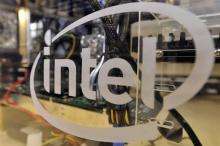NVIDIA files counter-suit in legal row with Intel

A legal battle between Intel and NVIDIA heated up on Thursday with the graphics computing specialty firm accusing the world's largest chip maker of breaching a contract.
NVIDIA filed a suit against Intel in a Court of Chancery in the US state of Delaware in response to Intel asking a judge there last month to settle a squabble between the two Northern California firms.
"NVIDIA did not initiate this legal dispute," said NVIDIA chief executive Jen-Hsun Huang.
"But we must defend ourselves.... Intel's actions are intended to block us from making use of the very license rights that they agreed to provide."
The companies have been arguing for a year about whether a deal they inked in 2004 allows NVIDIA to produce chipsets that work with Intel microprocessors that have integrated-memory controller features.
Intel filed a complaint in Chancery Court in February, asking a judge to decide which side is right.
"We got to the point where we said 'this is enough," Intel spokesman Chuck Malloy told AFP when the complaint was filed.
"We aren't seeking an injunction or asking for damages. It has just been a very longstanding dispute and we couldn't resolve it, so we will let the court decide."
NVIDIA argues in its counter-suit that it is within the bounds of a contract that Intel is breaching to put the graphics chip maker at a disadvantage.
Huang said at the outset of the litigation that Intel's true goal is to stymie graphics processing unit (GPU) technology that is becoming a competitive threat to computer central processing units (CPUs).
Intel counters that NVIDIA is telling customers of plans to make chipsets that violate the four-year-old licensing agreement and that it wants to avoid potential troubles before products are rolled out.
NVIDIA, founded in 1993, became renowned for GPUs that drive sophisticated computer game and video hardware.
While CPUs typically handle tasks in a linear style, zipping from start to finish in series, GPUs work on tasks simultaneously in order to do things such as get color pixels together on screens to present moving images.
Sets of NVIDIA chips built for speed, power and superior graphics replaced Intel models in upgraded MacBook laptop computers recently rolled out by Apple. MacBook computing tasks are still done by Intel CPUs.
Acer, Alienware, Asus, Dell, HP, Lenovo, MSI, NEC, and Toshiba are among the computer makers that combine NVIDIA and Intel technologies in hardware.
(c) 2009 AFP


















